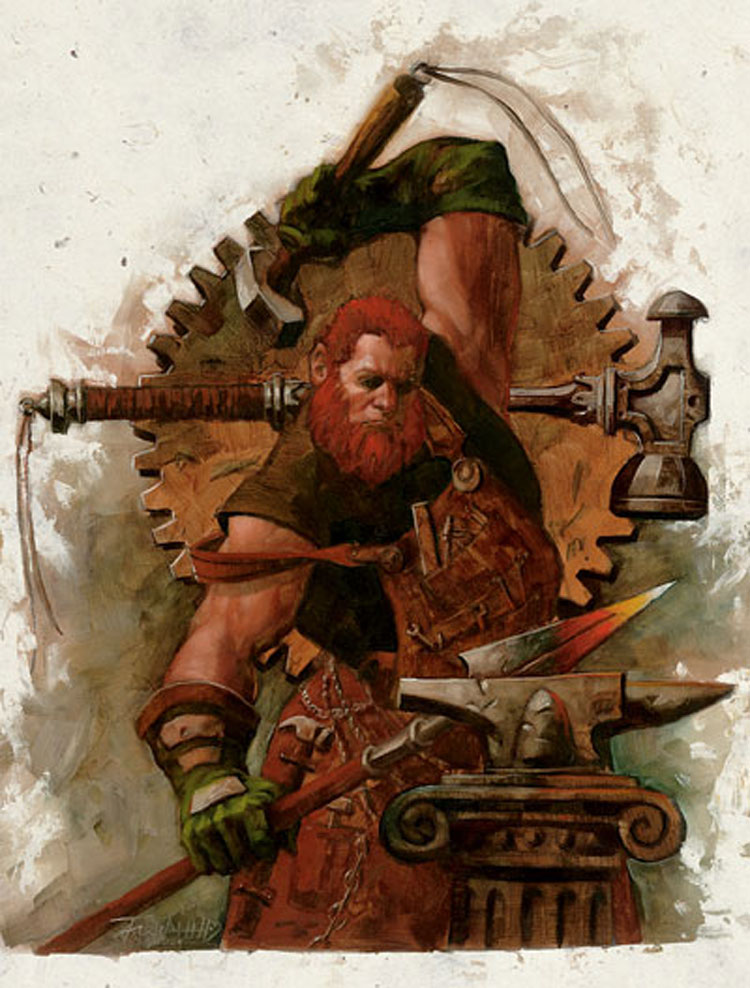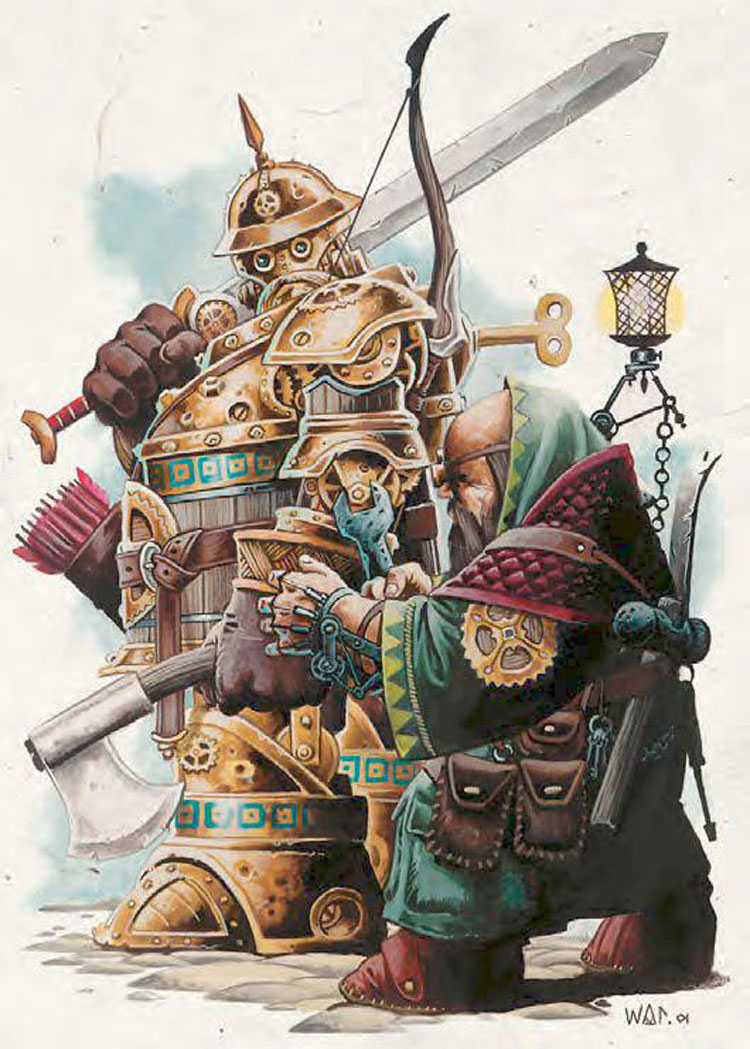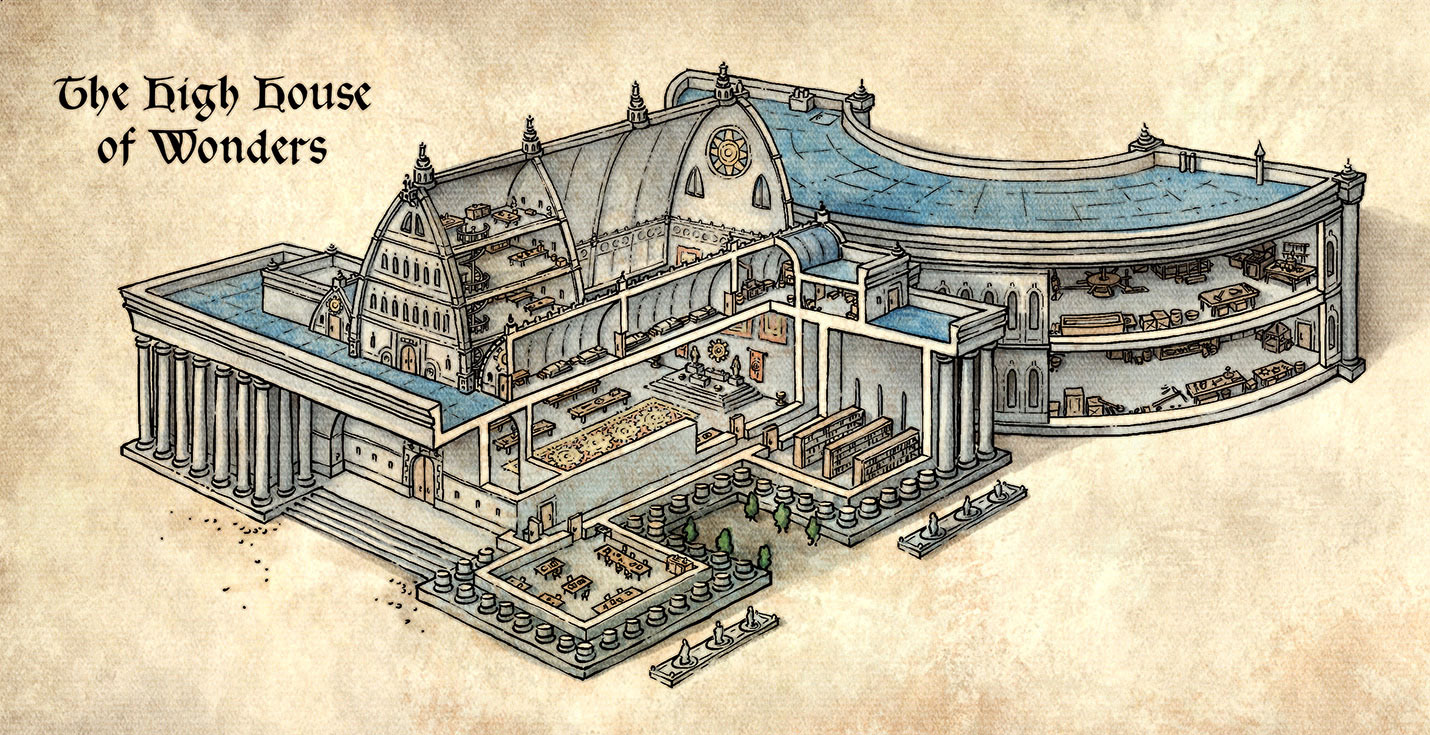Gond
Gond (gahnd) is a burly smith with a mighty hammer, forge, and anvil that allow him to craft the stuff of stars. Venerated by humans and gnomes (who know him as Nebelun) alike, Gond transforms ideas into concrete form and inspires mortals to make new things. He cares only for the act of creation, playing little heed to the consequences of letting loose his inventions into the world. Some in the Church of Mystra oppose the Wonderbringer for holding technology over the Art, but in truth Gond views magic as simply another tool by which he can create new devices.
Worshipers
The church of Gond is largely tolerated across Abios. Its members are found in human-ruled bastions of evil and strongholds of good alike, as well as in an increasing number of rock gnome communities. Only in the southern part of Lyetia is his faith preeminent. Most merchants cultivate strong relationships with the local clergy of the Wonderbringer, in hopes of acquiring and selling their latest inventions at great profit. However, at times the followers of Gond inadvertently create something that upsets existing markets, earning them sudden and unexpected hostility from other faiths.
Clergy
Clerics of Gond pray for their spells in the morning before the morning meal. Daily rituals to Gond are simple: muttered prayers upon rising and retiring, which are often incorporated into dressing or disrobing, and a longer prayer of thanks at the main meal. Clerics offer a special prayer of thanks and dedication of their work before commencing any new creation (as opposed to repair or maintenance). Their one holy festival is the Ippensheir, named for Ippen, Gond’s First Servant, and celebrated during the twelve days immediately following Greengrass1. All clergy of Gond and his devout worshipers gather at a temple, abbey, or holy site where a famed inventor or craftsmen once worked. It is a time of feasting, drinking, and revelry, during which they show inventions to and share innovations with their fellow Gondar. Some visit as many gatherings of the faithful as they can during this time, using a network of portals maintained by the church to link major defensible holy houses.
One strange practice of the faith requires that Gondar make two copies of any new machine or tool they discover, if possible. One copy is hidden away against the prying eyes of thieves or vandals for later display to fellow Gondar, and the other is smashed--or preferably, burned--as part of the Sacred Unmaking, a prayer of offering to Gond. This ceremony reinforces Gond’s dominion over both constructive and destructive engineering. Some clerics multiclass as rogues, but only out of an interest in lock picks and other small tools.
Except in the south of Lyetia, the church of Gond consists largely of itinerant clerics who move from town to hamlet to city, finding employment as master crafters, builders, smiths, and engineers. Settling in one place is frowned upon unless a cleric can show his or her superiors that the prospective home is a center for innovation that bears constant watching, such as Bhaevor, Bayvale, or Thruin'Tor. The church encourages making a handsome living in service to the Wonderbringer, however, for how better to demonstrate the rewards of following the Way of Gond? As they travel, Gondar clergy establish caches, investments, and alliances, and grab samples of any new inventions they come across. It is their duty to assist inventors and innovators and to file regular reports with the nearest Master (one who leads a religious community or tends a holy site) by means of messengers of the faith.
Gondar clergy wear saffron ceremonial vestments with a crimson collar and stole. Over the right or left shoulder, they wear a leather sash ending in a large pouch. The sash is dotted with small metal tools, gears, wire, cord, locks, hooks, hasps, buckles, and bits of steel, tin, and wool--in short, anything that might prove interesting or useful in a pinch (including lock picks for those skilled at such things). Their vestments also include enormous sunhats and belts of large, linked metal medallions. They wear Gond’s holy symbol as a pendant fashioned of bone, brass, bronze, or ivory.
Temples
Temples of Gond tend to be imposing stone structures, boxy in shape and encircled with stout-pillared porticos. Little decoration adorns the interior aside from sprawling displays of items created by members of the clergy. Some such exhibits are of historical interest, while others represent the latest creative endeavors of master crafters. The central altar of the temple always involves a massive anvil surrounded by endlessly spinning cogs in a great machine. Backrooms serve as workshops, crammed with projects both ongoing and abandoned.
The heart of the Gondar faith is the High House of Wonders in the city of Drova in Lyetia. This large, walled monastery is run by Danactar Tharmur the High Artificer, Most Holy Servant of Gond, the highest-ranking mortal cleric of the Wonderbringer.
Outside the ecclesiastical hierarchy, most members of the church of Gond are members of one or more honorary orders and societies sponsored by the faith. These include the Order of Puissant Stonemasons and Stonecarvers, the Holy Order of Most Skilled Architects and Bridgemakers, the Armorers of the Wonderbringer, the Society of Creative Castle Design and Construction, and the Industrious Brothers and Sisters of Carpentry, Cabinetry, Puppetry, and Toymaking.
Dogma
Actions count. Intentions and thought are one thing, but it is the result that is most important. Talk is for others, while those who serve Gond do. Make new things that work. Become skilled at forging or some craft, and practice making things and various means of joining and fastening until you can create devices to suit any situation or space. Question and challenge the unknown with new devices. New inventions should be elegant and useful. Practice experimentation and innovation in the making of tools and the implementation of processes, and encourage these virtues in others through direct aid, sponsorship, and diplomatic support. Keep records of your strivings, ideas, and sample devices so that others may follow your work and improve on what you leave behind and encourage others, such as farmers and hunters, to think of new tools, improved ways of crafting and using their existing gear, and new ways of doing things. Observe, acquire, and store safely the makings of others and spread such knowledge among the Consecrated of Gond. Discuss ideas and spread them so that all may see the divine light that is the Wonderbringer.
Relationships
1 - Greengrass was a festival to welcome in the first day of spring in the Abian Calendar. It occured annually on the 1st of Mowe. Traditionally, the wealthier people brought out flowers to give to the less wealthy, who either wore them or spread them on the ground to encourage the deities to usher in the summer.
Divine Classification
Intermediate Deity
Honorary & Occupational Titles
- Wonderbringer
- Lord of All Smiths
Children
Gender
Male







Comments